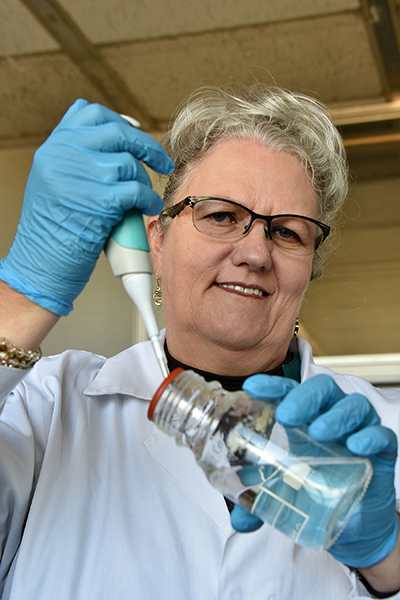Latest News Archive
Please select Category, Year, and then Month to display items
07 January 2018
Photo Charl Devenish
 Dr Anneke van der Spoel van Dijk is invested in contributing
to the global effort of stopping TB by 2035.
Dr Anneke van der Spoel van Dijk is invested in contributing
to the global effort of stopping TB by 2035.
The work of Dr Anneke van der Spoel van Dijk investigates the spread of TB in the Free State population using techniques such as next generation sequencing, spoligotyping and MIRU-VNTR typing. Dr Van der Spoel van Dijk, a senior medical scientist in the Department of Medical Microbiology at the University of the Free State (UFS) also looks at drug resistance in her research. This work informs decisions about how best to treat patients with multidrug-resistant TB (MDR-TB).
She employs rapid molecular techniques to track one of Africa’s most serious diseases, tuberculosis (TB).
Drug resistance
Scientists assist the National Health Laboratory Service and Department of Health in trying to refine the diagnostic tools to identify these cases earlier. Dr Van der Spoel van Dijk explains: “Until recently, it took up to two years to fine-tune treatment decisions for patients with MDR-TB. Patients get a cocktail of anti-TB drugs, but it takes time to find the right combination. Re-infection and relapse (patients stopping treatment for several reasons) add to the diagnostic and treatment management challenges.
Enormous impact
“Now doctors can reduce the time needed for diagnostic certainty to about seven days, while new drugs allow reduction of treatment from more than 18 to nine months. This can have an enormous impact on the life of many patients.”
Dr Van der Spoel van Dijk’s work forms part of research in the faculty looking at resistance development in TB strains. She is currently also doing her doctoral thesis on the differences and incidence of MDR-TB among adolescents versus adults. Dr Van der Spoel van Dijk says: “It is a complicated picture, but we hope to unravel it to support better diagnostic tools and patient care.”
As part of the National Health Laboratory Service, her department is playing an important role in TB diagnostics and the training of scientists and future pathologists. “Our work is contributing to the global vision to stop TB by 2035,” Dr Van der Spoel van Dijk says.
Romania and UFS work together on diagnostic programme
2009-04-28
 |
Here are, from the left: Dr William Rae with Prof. Chirvase and Prof. Caramihai of the Romanian research team during their visit to Bloemfontein.
Photo: Supplied
|
| A group of academics of Romania visited the Department of Medical Physics of the Faculty of Health Sciences at the University of the Free State (UFS) recently. Proff. Mihai Caramihai and Ana Chirvase are senior researchers of the Facultatea de Automatica & Calculatoare, Universitatea Politehnica Bucuresti who are working together with Prof. Charles Herbst and Dr William Rae of the UFS on the project MAmmary Malignancy Modelling using Artificial intelligence, ROmania South Africa, or Mamma Rosa. It is part of a larger local project aimed at implementing a computer-aided diagnosis programme (CAD), designed within the UFS's Department of Medical Physics, and which will take into account some of the South African requirements for computerised diagnostic radiology support. The National Research Foundation (NRF) provided travel funding and Prof. Herbst and Dr Rae visited Bucharest in November 2008 to collaborate with the Romanians. The visiting Romanian researchers were involved in a similar project where they were planning to model the changes in tumours as they grow and as they are treated. Dr Rae says there are many synergies between the two departments. The project has many aspects and there are several possibilities for related sub-projects. As a result the UFS has been able to attract three people to be involved in the project and they will do their Ph.Ds with the UFS. On the visit to Bloemfontein the roles of the researchers in the project were defined and the programme for the three-year collaboration was established. The stimulus created as a result of this collaboration has resulted in projects that will continue for at least the next four years. |